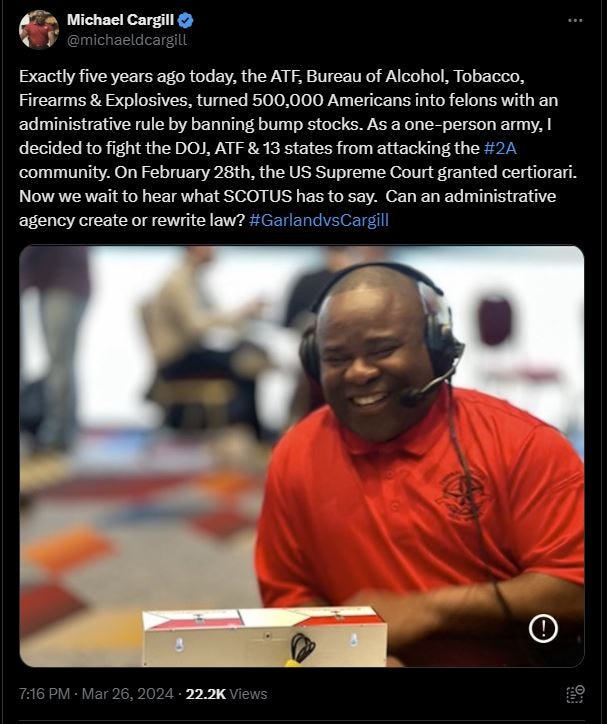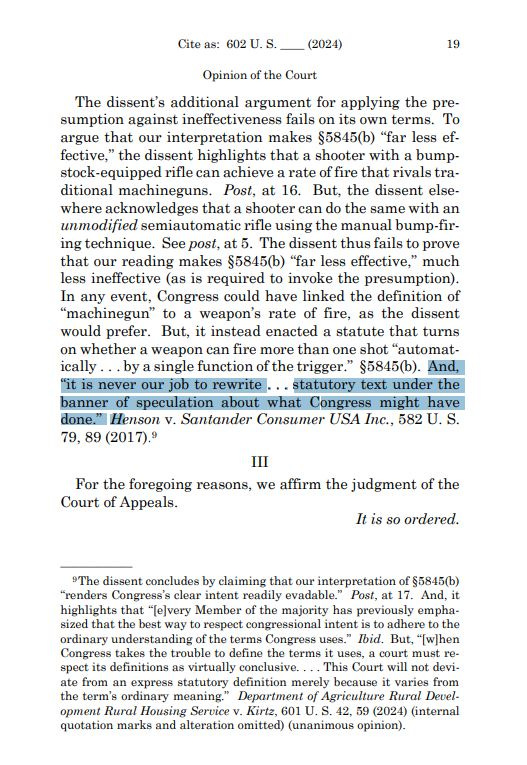As we near the end of the Supreme Court’s current term, decisions on cases heard this term are being released. We are all waiting for some very big shoes to drop, namely Chevron Deference, Missouri v Biden, and Trump Immunity cases. But today we got a big one: Cargill v Garland. Many of you may not know the background on this case. In the wake of the horrific Las Vegas rampage killing where Stephen Paddock murdered fifty nine innocent people and wounded hundreds, the political pressure to ban bump stocks, a rifle stock that can be fitted to an AR-15 to increase its rate of fire. Under then-President Donald Trump, an executive order was given to the ATF to create a regulatory ‘rule’ that would re-classify ordinary bump stocks as machine guns, forcing them to be registered under the National Firearms act of 1934.
This immediately began a legal battle between Americans who had previously to the rule’s taking effect lawfully possessed and owned bump stocks. Their issue was the inclusion in the NFA: by re-classifying bump stocks as NFA regulated items, anyone not registering or surrendering their newly minted ‘machine guns’ would be subject to 10 years in prison and a $250,000 fine for each device if caught possessing it. The rule turned hundreds of thousands of law-abiding Americans into felons with the stroke a pen. Michael Cargill, after surrendering his bump stock, now with demonstrable injury (loss of property under coercive threat) sued the government. And so began Cargill’s case, later renamed upon Merrick Garland’s assumption of the office of Attorney General, as the overseeing figure responsible for the ATF who promulgated the rule.
Just as in the the cases VanDerStock v Garland where ATF unilaterally exceeded it’s authority and re-wrote the Gun Control Act of 1968 by promulgating a regulatory ‘rule’ to de facto ban 80% firearms frames/receivers to prevent Americans from creating home made firearms that were born outside the ATF’s illicit tracking program, the Cargill rule re-wrote the 1935 gun control act to de facto ban bump stocks. In a nearly identical case, the ATF created a rule declaring pistol braces which are commonly used by Americans with disabilities to effectively use AR-15s and other similar firearms to be ‘Short Barreled Rifles’ thus adding them the National Firearms Act. This resulted in another lawsuit against the ATF, claiming the Executive Branch agency exceeded its authority, and violated the separation of powers by creating new law. In Mock v Garland, the ATF suffered a stinging blow as Judge Reed O’Conner ruled that ATF violated the Administrative Procedures Act and vacated the rule. Vacatur strikes the rule from the federal list of regulations as if it never existed. It quite literally nukes it from orbit.
The ATF under the Biden Regime has ramped up illegal ‘rule’ making in order to cart blanche pursue Biden’s rabid anti-gun agenda. But these decisions get to the heart of a much bigger problem: The Administrative State of the Executive Branch exceeding its authority without the effective checks and balances of other branches of government correcting the over reach, from the EPA’s loss on their re-writing of the clean air act to try to force the adoption of Electric Vehicles to the ATFs rules advancing gun control.
Yesterday, the US Supreme Court’s decision in Cargill v Garland was released and it immediately made waves in the legal world. The majority decision, authored by Justice Clarence Thomas, rules that the ATF exceeded its authority by attempting to add bump stocks to the NFA, as they do not meet the LEGAL DEFINITION of what a machine gun is. The ATF’s problem in this case, like all the cases I discussed in this article is that the National Firearms Act explicitly spells out what a machine gun is, and while bump stocks seem to replicate that function, they do not meet the legal criteria and ATF cannot legally add them. They knew this, but promulgated the rule anyway. What’s noteworthy in this decision is that its language appears strongly aimed at not just this case but other cases before the court and even at lower courts ignoring/defying other recent US Supreme Court rulings, namely the Bruen decision.
Keep reading with a 7-day free trial
Subscribe to Harold Finch’s Substack to keep reading this post and get 7 days of free access to the full post archives.





